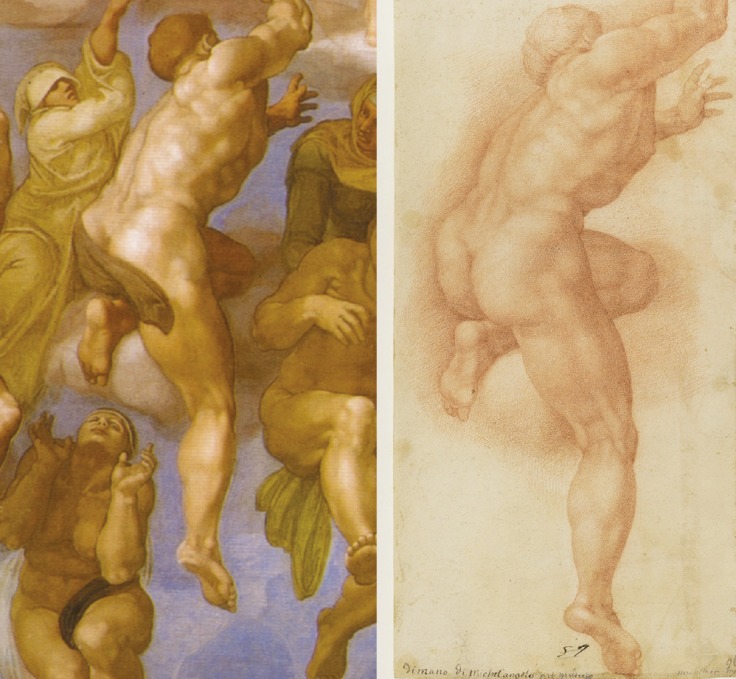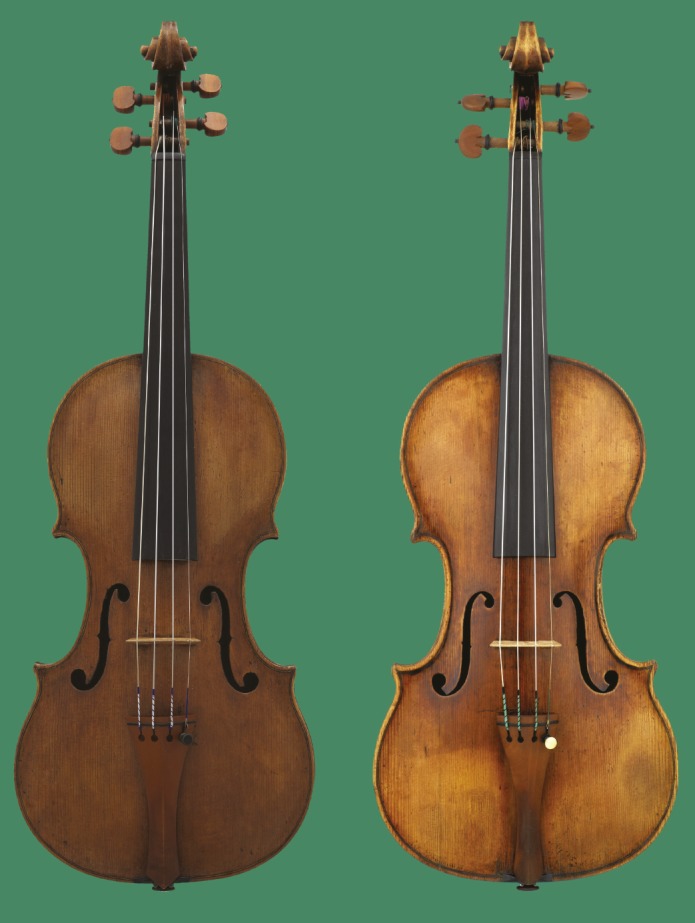Hydrogel helps restore artworks and reveals hidden inscription

(Left) Detail from the Ascesa dei Beati by Michelangelo from the Sistine Chapel; (Right) 16th-century drawing reproducing the same detail and showing the inscription (artist unknown).
Many ancient and contemporary artworks are marred by pressure-sensitive tapes, which are composed of an adhesive, such as rubber or silicone, layered atop a support, such as paper or fabric. Current methods to remove adhesive tapes from artworks rely on solvents, which can spread across and irreversibly disfigure the underlying artwork. To noninvasively remove adhesive tapes from paper artworks, Nicole Bonelli et al. (pp. 5932–5937) fashioned a hydrogel into which a nanostructured fluid was embedded. The fluid was composed of droplets of the organic solvents ethyl acetate, 1-pentanol, and propylene carbonate stabilized in water by the surfactant sodium dodecyl sulfate. Using the fluid-loaded hydrogel cut to match the size and shape of the adhesive tapes, the authors safely detached the tapes from two 20th-century drawings by the Portuguese–French abstractionist Maria Helena Vieira da Silva and the American artist Helen Phillips Hayter. Similarly, applying the hydrogel to a fragment of rubber-on-cellulose tape on a 16th-century rendering of a scene of The Last Judgment by Michelangelo in the Sistine Chapel helped safely remove the tape. Hidden underneath the tape was the inscription “di mano di Michelangelo,” which the authors believe to be a false attribution obscured with the tape by a collector. The authors also used the hydrogel to remove tape-induced discolorations on a ballpoint pen and tempera drawing by the 20th-century Italian artist Lucio Fontana; wet cleaning, by contrast, can erase pen strokes. According to the authors, confining the nanostructured fluid to the hydrogel enables rapid removal of adhesive tapes without lateral migration of solvents into artworks, and the hydrogel can be easily recharged for multiple applications. — P.N.
Rett syndrome and messenger RNA profiles
Rett syndrome, a severe neurodevelopmental disorder, affects girls in early childhood, triggering regression in previously acquired speech and motor skills. The disease is primarily caused by mutations in the MECP2 gene, but the underlying molecular mechanisms remain unclear. Using a mouse model of Rett syndrome, Sivan Osenberg et al. (pp. E5363–E5372) demonstrate that neuronal activity induces an abnormal global pattern of gene expression in the brain, as well as aberrant alternative splicing—the process by which a precursor messenger RNA (mRNA) molecule transcribed from a gene gives rise to multiple types of mature mRNAs encoding distinct proteins. The authors injected MECP2-mutant mice and control mice with kainic acid to stimulate neurons, isolated the hippocampus, and used RNA sequencing to analyze mRNA profiles. Neuronal activity induced higher expression levels of 281 genes, as well as 560 distinct alternative splicing events, in MECP2-mutant mice compared with control mice. In particular, mRNAs from mutant mice consisted of more retained introns—nucleotide sequences that usually do not code for amino acids—as well as three times as many skipped or excised exons—nucleotide sequences that encode amino acids. According to the authors, the findings suggest that MeCP2 is required for regulating changes in gene transcription and alternative splicing in response to neuronal activity. — J.W.
Antique Italian violins mimic human voice

Amati (1570) and Stradivari (1722) violins. Image courtesy of the Chimei Museum.
Andrea Amati, the early 16th-century Cremonese luthier, is considered the father of the modern four-string violin. Amati’s design has stood the test of centuries, largely owing to its favorable acoustic features. Hwan-Ching Tai et al. (pp. 5926–5931) attempted to test the hypothesis that the acoustic properties of old Italian violins, including Amati and Stradivari violins, resemble those of the human singing voice. The authors used speech analysis techniques to examine the scales of 15 antique Italian violins played by a professional violinist and recorded at Taiwan’s Chimei Museum, as well as those of eight men and eight women, ranging in age from 16 to 30 years, who sang common English vowels. Analysis of frequency response curves and formants, which are resonance frequencies originating from standing waves in the vocal tract, revealed that an Amati violin dating to 1570 and a Gasparo da Salo violin dating to 1560 mimicked the formant properties of male singers, raising the possibility that master luthiers from this period may have designed violins to emulate male voices. In contrast, Stradivari violins were marked by elevated formants, making them more similar to female voices—a feature that the authors suggest might account for the violins’ storied tonal quality. According to the authors, antique Italian violins can produce formants that recall the human singing voice. — P.N.
Handedness and birthweight
As early as 10 weeks of gestation, when growing human fetuses begin moving their arms, the question of whether the newborn will be left-handed, right-handed, or ambidextrous is addressed. Previous studies have suggested direct links between left-handedness and both low birthweight—less than 1.5 kg—and preterm birth. Because newborn triplets are around 1.5 kg lighter than singletons, Kauko Heikkilä et al. (pp. 6076–6081) examined links between birthweight and handedness in two large datasets composed of 1,305 triplets from Japan and 947 triplets from the Netherlands of average gestational age of around 33 weeks. Whereas the average birthweight of left-handers in the Japanese sample was 1.599 kg, right-handers weighed 1.727 kg on average. Similarly, left-handers in the Dutch sample weighed 1.794 kg on average compared with the average birthweight of 1.903 kg for right-handers. Analysis within and between families also suggested a link between left-handedness and low birthweight, regardless of maternal or gestational age. By contrast, handedness appeared to be unrelated to birth order in both samples. In the Japanese sample, left-handers reached motor milestones significantly later compared with right-handers; no such association was observed in the Dutch sample. Though the study did not account for maternal stress, birth complications, or fetal focal brain injuries, it reinforces the link between left-handedness and low birthweight using a large triplet data set, according to the authors. — P.N.
Archaeological finds illuminate Roman Empire battle

Four ossa coxae threaded onto a stick.
The northern expansion of the Roman Empire between the first century BC and the first century AD was marked by pitched battles with Germanic tribes, whose ferocity was a frequent subject of Roman military lore. However, a dearth of well-preserved human remains at purported battle sites has hampered understanding of the nature of the fighters, weaponry, and battlefield practices. Mads Kähler Holst et al. (pp. 5920–5925) report the results of archaeological excavations undertaken between 2010 and 2014 at the Alken Enge wetlands in Denmark’s Illerup River valley. Dispersed in peat and lake sediments in over 75 ha of wetland meadows, nearly 2,100 human bones and bone fragments were unearthed and radiocarbon-dated to 2 BC to AD 54. The human remains were accompanied by ceramic pots and the bones of dogs, pigs, and cattle, along with weapons, such as an axe, spearheads, sword and shield fragments, and iron knives. The human bone fragments, which represent 82 individuals, mostly adult male, bear signs of trauma before and around the time of death, as well as tooth marks and fissures caused by foxes, dogs, and wolves. Together, the evidence at Alken Enge suggests large-scale armed conflict by an estimated population of 380 young men who sustained combat injuries, lending support to previous accounts of military prowess in northern Germania. The discovery of cut marks on bones, bone assemblages, and hip bones threaded on a stick suggests that human bones may have been collected and treated in the battle’s aftermath and hints at the possibility of ritual in the disposal of human remains, according to the authors. — P.N.


